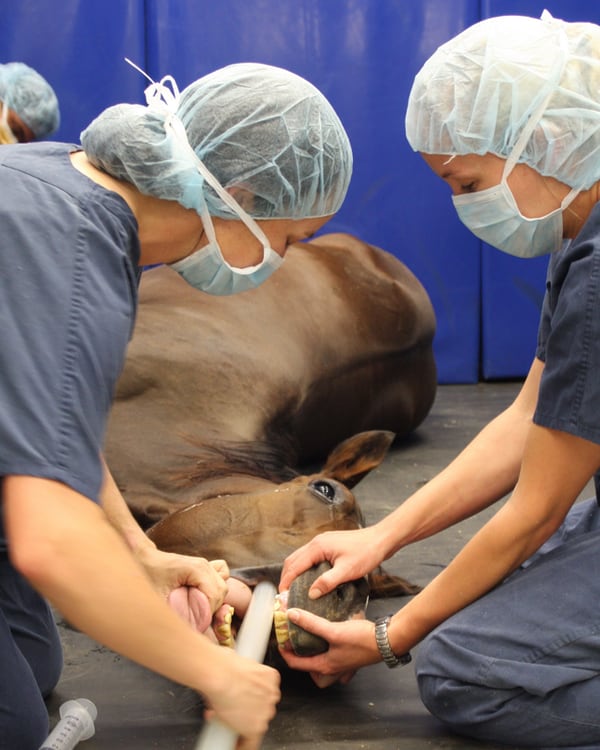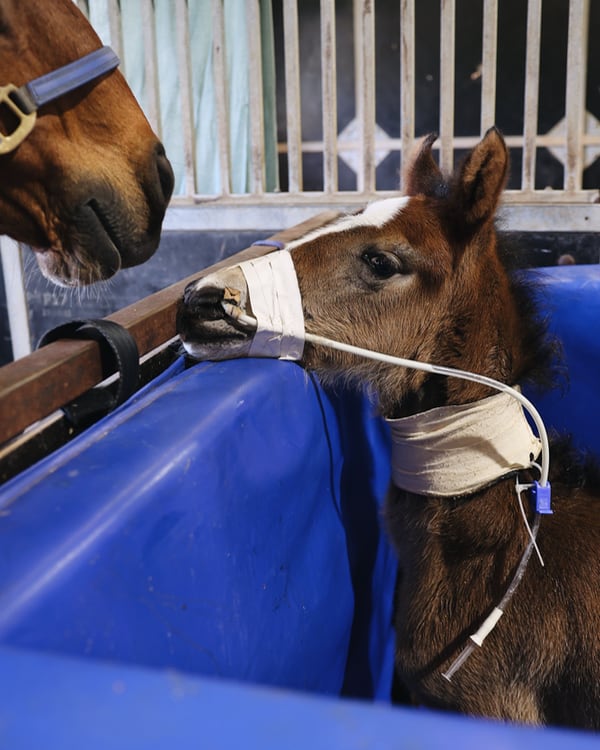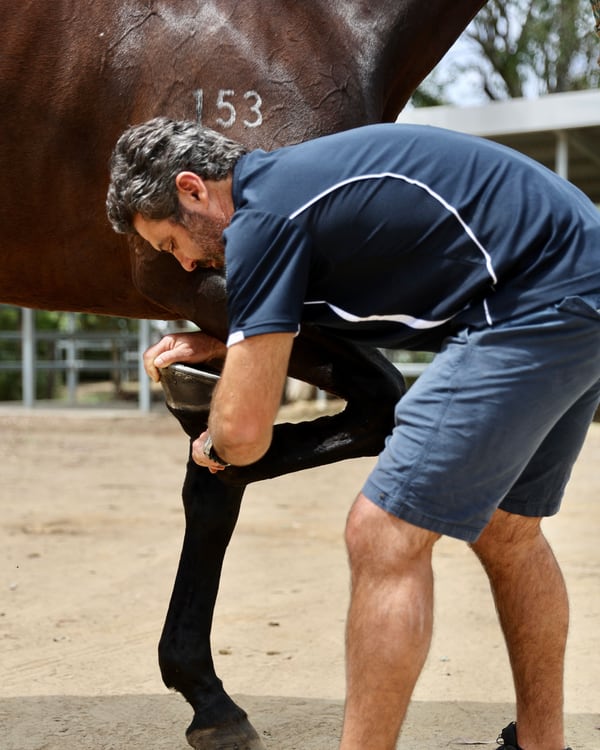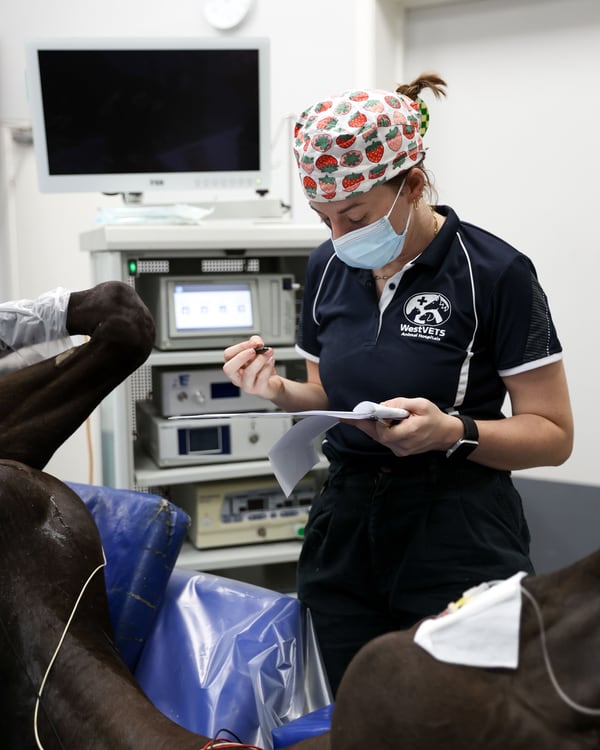Equine Vet Services
WestVETS is dedicated to providing comprehensive veterinary care for equine patients. With a 24-hour emergency service, our experienced team of veterinarians, specialists, and nurses is available around the clock to address any equine emergencies that may arise. We offer a full range of surgical and medical services, ensuring that your horse receives timely and effective care, no matter the time of day or night.
At WestVETS, we are committed to providing dedicated and accessible veterinary services to ensure the well-being of your horses.
Equine Surgery
At WestVETs Equine Hospital, our operating theatre is fully equipped with a hydraulic surgery table and a mechanical gantry system, ensuring optimal conditions for procedures. Additionally, we provide a padded recovery room to ensure comfortable post-operative care. Our hospital is equipped with a state-of-the-art ventilator and specialized monitoring equipment specifically designed for horses.

Sports Medicine
WestVETs Equine Hospital is equipped with an operating theatre outfitted with a hydraulic surgery table and mechanical gantry system as well a padded recovery room. We have a state-of-the-art ventilator and specialized monitoring equipment for horses.

Medicine and Intensive Care
Our Equine Hospital is located at our Anstead facility and consists of 9 intensive care stables, a isolation stable block with CCTV monitoring as well a 20 more stables for non-intensive cases. We have a purpose built equine operating theatre and a padded recovery room linked by a mechanical gantry system. We have a large diagnostic area with two crushes as well an air-conditioned room with a crush for standing surgeries.

Ambulatory and Preventative Medicine
WestVETS has fully equipped vehicles and mobiles crushes to visit your property. We offer both routine and emergency services at your property.
We also offer Annual Health Packages that include a visit, dental, annual vaccinations and dewormer.

Prepurchase Examinations
When it comes to purchasing a horse, a prepurchase examination is a crucial step to ensure a sound investment. At WestVETS, we understand the significance of this process, and we offer standard prepurchase examinations that adhere to the guidelines set by the Australian Equine Veterinarian Association.

Equine Dentistry
Regular dental examination and treatment are essential for every horse, regardless of their role or activity level. At WestVETS, we understand the significance of proper dental care for horses. Our experienced veterinarians specialize in equine dentistry and are equipped to provide comprehensive dental services to meet your horse’s needs.

Emergency
WestVETS offers a 24 hour emergency service for equine patients. Our dedicated team of experienced veterinarians, specialists and nurses offers a full surgical and medical service round the clock. We also have veterinarians on duty for property and stable visits.

FAQ
All horses require regular dental attention. The age of the horse, type of feed being fed and the purpose the horse is used for all determine how often dentistry should be performed. As a general rule, horses should have their teeth checked and treated at least every 12 months, unless otherwise recommended. Young horses less than 8 years often require six monthly attention. All horses with severe dental conditions require more frequent attention.
Horses in this area are generally vaccinated against tetanus and strangles with a single yearly vaccine known as ‘2 in 1’. For unvaccinated horses or those whose vaccination status in unknown, a course of three injections should be given. The first injection is a 2 in 1 followed two weeks later by a strangles only vaccination. A further 2 in 1 is given two weeks after the strangles injection. Yearly 2 in 1 boosters are then required.
Foals are given the same vaccination protocol with the first injection being given at 12 weeks of age. If the mare that has foaled is not vaccinated, the foal may also be given a tetanus antitoxin at 1 day old.
Horses should be wormed approximately every six to eight weeks depending on the product used. Some products which are a gel formation can be used less often. Foals should be regularly wormed as well usually starting at eight to twelve weeks of age.
It is important to note that worming products differ in their spectrum of activity. Some effectively kill all the important parasites whilst others may not be effective against individual parasites such as tapeworms and bots.
All horse feet require regular attention, however not all horses required shoeing. Regardless, the attention of a farrier should be sought approximately every six weeks.
The rapid intake of large volumes of food containing high levels of carbohydrates can be dangerous to a horse. If your horse has consumed a large volume of feed it is best to contact your vet for advice as immediate medical attention may be required.
Horses that seem to be in pain, roll, paw or look at their flanks may be suffering from colic. Colic is abdominal pain, usually from the gastrointestinal tract and is a serious condition in horses. Urgent veterinary advice and attention should be sought.
Whilst waiting for veterinary attention it is important to stop your horse from rolling. It is OK if he is lying quietly, but rolling should be avoided. Be careful not to get yourself hurt however, as a horse in pain is not always aware of its surroundings. The best way to stop your horse rolling is to keep him walking until help arrives.
Sore and weeping eyes should always receive veterinary attention, particularly if only one eye is involved. Conditions of the eye can progress quickly if left untreated and can be serious.
It is abnormal for a horse to have runny eyes all the time. In a normal eye the tears produced drain via the ‘naso-lacrimal’ duct, which runs from the inside corner of the eye down to the nostril. If your horse constantly appears to be ‘crying’ then there may be an increase in tear production or a problem with the naso-lacrimal duct.
The naso-lacrimal duct can occasionally become blocked for various reasons. To name a few examples; debris from the environment, growths such as squamous cell carcinomas or Habronema (parasite), or previous injury and subsequent scar tissue can all potentially lead to a partially or completely blocked tear duct.
An increase in tear production can be due to chronic irritation. This can occur from irritants such as dust, which can then progress to conjunctivitis. Growths in the eye, such as squamous cell carcinomas, can also cause an increase in tear production.
Eye ulcers can cause a teary eye but in these cases the eye will also be painful. A horse with a painful eye will blink excessively and partially or completely shut its eye. If your horse has a painful eye you should call your veterinarian immediately. Equine eye ulcers have the potential to develop into devastating melting ulcers within 24 hours so these must be treated seriously.
Runny eyes are abnormal so it is recommended that you have your veterinarian examine your horse if this is occurring.
The average gestation length for a horse is 340 days, and ranges from 320 to 360 days. Pony mares often have a slightly shorter gestation.
The first stage of labour for a mare is often very subtle and may be missed by many owners. It may last for up to 24 hours and is the period during which the mare is preparing to give birth. She may appear restless, slightly sweaty and may get up and down. Some mares will drip a small amount of colostrum.
The second stage of labour is when the mare gives birth. It consists of multiple forceful contractions. The foal should be delivered with 20-30 minutes of the sac rupturing (water breaking). Prolonged foaling increases the possibility of problems with the foal and mare and veterinary advice should be sought if the mare has been contracting for 30 minutes without a foal being born.
Other signs the mare may be experiencing difficulties include evidence of strong contractions with no progression of the delivery process with in 10 minutes of rupture of the sac or the presentation of hind feet or upside down feet.
The third stage of labour is the expulsion of the placenta and is regarded as being normal if it occurs 30 minutes to 3 hours after the foal has been born. It is important to ensure that the entire sac has been expelled intact. If the mare has not passed the placenta within 3 hours of giving birth or it does not appear intact, veterinary advice should be sought.
Foals should be alert shortly after birth and should quickly make attempts to stand. A normal foal should be on its feet within 45 minutes of birth. It is imperative that foals suckle from their mothers in the first few hours of life as it is during this time that they receive colostrum and the antibodies they need to fight infection. A foal should be suckling within 2 hours of being born.
Foals should be bright and bouncy. Foals can become sick quickly and deteriorate even quicker. It is important that you seek veterinary advice if you are at all concerned.
If your horse is reluctant to flex to one side when being ridden it could be behavioural or a lack of training. However if your horse has previously been willing and able to flex to both sides and this suddenly changes it is possible that there is pain causing the resistance.
Pain anywhere from the mouth all the way along the spine can result in a reluctance to flex. Your veterinarian will be able to diagnose dental issues and pain arising from skeletal or muscular origins. One example of this could be overriding of the spinous processes of the thoracic vertebrae causing pain. This can be exacerbated when riding and potentially when the horse is asked to bend and flex to one direction.
If you suspect pain as the cause of your horse’s flexion avoidance you should call your veterinarian.
One of the main functions of your horse’s large intestines is to absorb fluid from the ingesta and therefore form faecal balls. Numerous factors can affect the absorption of fluid from the intestines and sloppy manure results. Some examples of conditions that can affect absorption are:
- Parasites – intestinal worms cause irritation and inflammation in the intestinal wall as they emerge from their cysts and feed. This inflammation reduces the intestines ability to absorb fluid.
- Sand – Horses kept on pastures with a sandy soil can ingest variable amounts of sand. Sand is heavy and remains in the intestines causing irritation and inflammation.
- Inflammatory Bowel Disease (IBD) & Intestinal Neoplasia – These conditions can occur in older horses and must be considered if other causes are ruled out.
Sloppy manure can also occur if the normal bacteria within the intestine are disrupted. This can happen for example if your horse’s diet is suddenly changed. In this case the bacteria need time to adjust and this is why new feeds should be introduced slowly.
Horses that are particularly prone to stress can at times pass a sloppy manure when faced with a stressful situation. However in these cases it should only be a one-off and then they should pass normal manure.
If your horse is passing watery diarrhoea or is consistently passing loose manure please contact your veterinarian immediately as this can be a life threatening situation.
If your horse is passing the occasional sloppy manure please contact your veterinarian to discuss potential causes, preventatives, and treatments.
If your horse is sensitive when you touch around its ears it will either be a behavioural issue or due to pain and discomfort.
Unfortunately, the vast majority of ear shyness stems from behavioural issues, meaning there usually isn’t a quick fix. These horses need patience, repetition, and understanding to help gain your horse’s trust and respect.
Luckily medical causes of ear shyness are rare but may be considered if there is a sudden onset of avoidance or if only one ear is seemingly sensitive. If this is the case, examine the ear/s for any signs of cuts, painful lumps, increase in discharge, or external parasites such as ticks.
If you suspect a medical cause for your horse’s ear shyness be sure to contact your local veterinarian.
The signs your horse may show when suffering from back pain can be wide and varied and may be subtle or overt.
Back pain will originate either from the bones of the spine or muscles supporting them. A horse with back pain may show any one of the following signs:
- Repeatable pain on palpation of the spine
- Reluctance to flex spine to the left or right
- Reluctance to flex spine upwards
- Resentment of saddling and grooming along the back
- Refusal/reluctance to jump or collect
- Abnormal hindlimb gait
The above points are only a few of the potential signs your horse may show and any signs must be interpreted in light of other possible causes such as behavioural problems or pain in another area. A history of trauma such as a floating accident or rearing up and falling over backwards can be useful but problems from such incidents can take years to manifest.
To diagnose a horse with back pain please seek the attention of your regular veterinarian. The source of your horse’s back pain can be diagnosed via skilled palpation, radiographs, blood tests showing elevated muscle enzymes, scintigraphy or thermography to name but a few.
